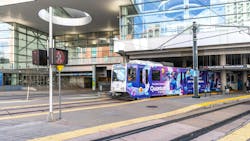Denver RTD lifts final light-rail speed restriction
The Denver Regional Transportation District (Denver RTD) lifted the last of 31 light-rail speed restrictions put into place last year on D, E, H and R lines as the agency implemented more rigorous standards for regularly inspecting the more than 120 miles of light-rail track.
The final speed restriction, an approximately 400-foot southbound segment north of Southmoor Station, was removed after crews completed the repairs during regular maintenance hours.
Track maintenance work and repairs
Inspections that began last May as Denver RTD intensified its focus on maintaining its assets in a state-of-good-repair found several minor issues and track imperfections along isolated sections of the agency’s light-rail network. Until preventative maintenance work could be completed, 10 mph speed restrictions were implemented across four separate slow zones. A team of nearly 100 Denver RTD staff, from rail laborers to track maintainers, worked in three shifts to safely complete the repairs.
Since last June, Denver RTD crews have removed and replaced 12,091 feet of track, or a distance of more than two miles, along the D, E, H and R lines. Removing more than 10,000 feet of existing rail primarily took place during limited overnight maintenance windows and required crews to power down the system’s overhead wires. The work also involved carefully transporting and staging new sections of track for installation along the corridors.
During the first nine months alone, more than 50 miles of rail underwent grinding to remove surface defects, reducing the risk of cracks forming in the future. Crews also installed joint bars and leveled the ballast that provides stability and supports the light-rail tracks. In total, Denver RTD says it has replaced, lined, tamped and surfaced more rail over the last year than it did during the previous 20 years combined. As sections of track were repaired, the length of slow zones was reduced and speed restrictions lifted.
Denver RTD began extending its overnight maintenance windows earlier this year to maximize the work being performed over the course of multiple consecutive days. Extending the windows allowed the agency to plan for disruptions and provide bus shuttles to support impacted customers. Work completed during this year’s extended overnight windows allowed the agency to fully lift nine speed restrictions between January and March.
Track inspections
Denver RTD adheres to the American Public Transportation Association standards for the periodic inspection and maintenance of transit tracks, which the agency began using last May. The standards include visual, electrical and mechanical inspections of components that affect safe and reliable rail operations, as well as standards for implementing necessary speed restrictions.
Once a year, Denver RTD notes it conducts an ultrasonic inspection of all 120 miles of light-rail track. An ultrasonic inspection uses high-frequency sound waves to detect internal flaws, cracks or other structural issues with the rail. Additionally, staff walk the entire system every 90 days to take additional measurements and carefully document any anomalies found. The quarterly walking inspections allow the agency to collect thousands of data points, identify recurring issues and analyze patterns. Twice each week, all 120 miles of track are also inspected using a hi-rail vehicle that drives the track at speeds where the rail can be carefully assessed.
Denver RTD has 14 track maintenance professionals who work year-round to ensure the regular cadence of rail inspections is completed. The agency says it’s in the process of increasing the number of its track maintenance employees to 18.
